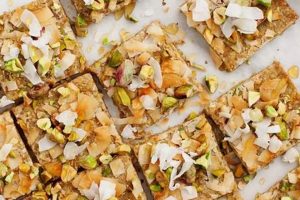Plant-based, uncooked sweets represent a category of confections that exclude all animal products and do not require oven use. Common ingredients include nuts, seeds, dates, coconut, and plant-based milks, often combined and chilled to achieve desired textures. Energy balls, raw cheesecakes, and layered parfaits exemplify this style of dessert preparation.
This approach to dessert creation offers several advantages, including ease of preparation and preservation of nutrients, as heating can degrade certain vitamins and enzymes. Furthermore, these recipes often cater to dietary restrictions beyond veganism, such as gluten-free and refined sugar-free diets. Historically, reliance on readily available, uncooked ingredients predates widespread oven availability, making these preparations a sustainable and accessible option.
The following sections will explore the variety of ingredients and techniques employed in creating these plant-based, oven-free treats, highlighting recipe adaptations and nutritional considerations for informed decision-making.
Essential Guidance for Plant-Based, Uncooked Confections
The following guidelines ensure successful preparation of plant-based, oven-free sweets, focusing on optimal ingredient selection and preparation techniques.
Tip 1: Ingredient Quality Matters: Prioritize high-quality nuts, seeds, and dried fruits. Organic options are preferable, and ingredients should be fresh to maximize flavor and texture.
Tip 2: Nut and Seed Activation: Soaking nuts and seeds prior to use can improve digestibility and nutrient absorption. This also softens them, facilitating smoother blending or processing.
Tip 3: Date Preparation for Smoothness: Soaking dried dates in warm water softens them, allowing for easier blending and a smoother texture in preparations like raw cheesecakes or caramel sauces.
Tip 4: Coconut Cream Consistency: Refrigerate full-fat coconut milk overnight. This allows the cream to separate from the liquid, yielding a thicker, more stable base for whipped toppings or fillings.
Tip 5: Fat Content Considerations: Ensure adequate fat content from sources like nuts, seeds, or coconut oil. This contributes to a richer flavor and improved texture, preventing a dry or crumbly result.
Tip 6: Sweetener Control: Opt for natural sweeteners such as maple syrup or agave nectar. Adjust quantities gradually, tasting frequently to achieve desired sweetness levels without overpowering other flavors.
Tip 7: Refrigeration for Setting: Allow sufficient refrigeration time for proper setting. Most plant-based, uncooked sweets benefit from at least 2-4 hours of chilling to allow flavors to meld and textures to solidify.
Adhering to these principles will enhance the quality and enjoyment of homemade plant-based, oven-free desserts, ensuring optimal flavor and texture outcomes.
The subsequent sections will delve into specific recipe adaptations and troubleshooting strategies for common challenges encountered in this culinary domain.
1. Simplicity
Simplicity is a defining characteristic of plant-based, uncooked confections, contributing significantly to their accessibility and appeal. The inherent ease of preparation expands the potential audience, making it a practical option for individuals with limited time or culinary expertise. Simplification arises from both ingredient selection and the elimination of baking processes.
- Minimal Ingredient Lists
Plant-based, uncooked dessert recipes often require fewer ingredients than their conventional counterparts. This streamlined approach reduces preparation time and complexity. For example, a simple date and nut-based energy ball can be created with as few as three ingredients, contrasting sharply with multi-component baked goods.
- Elimination of Baking Processes
The absence of baking simplifies the preparation significantly. This eliminates the need for oven preheating, temperature monitoring, and the risk of burning or under-baking. Recipes typically involve blending, mixing, and chilling, requiring minimal equipment and technical skill.
- Reduced Cleanup
Fewer steps and less equipment usage translate to reduced cleanup time. This is a notable advantage for individuals seeking quick and convenient dessert options. The majority of uncooked recipes involve only a food processor or blender, minimizing post-preparation chores.
- Direct Assembly Techniques
Many plant-based, uncooked sweets rely on direct assembly rather than complex techniques. Layering, rolling, and pressing replace the need for advanced culinary skills. This approach allows for immediate gratification and eliminates the learning curve associated with baking.
In summary, the simplicity inherent in plant-based, uncooked confections arises from streamlined ingredient lists, elimination of baking, reduced cleanup, and reliance on direct assembly techniques. These factors collectively contribute to their accessibility and make them a practical choice for diverse culinary contexts.
2. Ingredients
The composition of plant-based, uncooked confections is fundamentally defined by its ingredients. Selection of appropriate components dictates the final product’s flavor, texture, nutritional profile, and overall success. Omission of animal products necessitates reliance on plant-derived alternatives, requiring careful consideration of their functional properties and potential interactions.
Nuts and seeds, for example, serve as primary sources of fats and proteins, contributing to richness and structural integrity. Dates, maple syrup, and agave nectar function as sweeteners and binding agents. Coconut oil, a saturated fat, aids in solidification and textural enhancement. Fruits, both fresh and dried, introduce natural sweetness, moisture, and diverse flavor notes. Cacao powder or nibs provide chocolate flavor without requiring baking. The specific combination and proportions of these components directly influence the outcome. For instance, a raw cheesecake relies heavily on nuts and coconut cream for its creamy texture, while energy balls utilize dates for binding and sweetness. Substituting one ingredient for another can significantly alter the final product; swapping dates for maple syrup, for example, affects both sweetness and moisture content.
Understanding the role of each ingredient is paramount. Careful attention should be paid to sourcing high-quality components and adjusting proportions to achieve desired results. The interplay between ingredients dictates the overall success of these plant-based, uncooked desserts. This intricate relationship is a foundation for exploration into textural variations, sweetness management, and nutritional optimization.
3. Texture
Texture assumes a paramount role in the overall sensory experience of plant-based, uncooked desserts. The absence of baking necessitates reliance on alternative methods to achieve desired tactile qualities. Manipulating ingredient combinations and processing techniques allows for a diverse range of textural outcomes, impacting palatability and consumer acceptance.
- Creaminess from Cashews and Coconut
Cashews, when soaked and blended, create a remarkably smooth and creamy base, often utilized in raw cheesecakes and mousse-like desserts. Similarly, the solid portion of refrigerated coconut milk, known as coconut cream, provides a rich and velvety texture. The degree of blending and the fat content of the ingredients significantly influence the final creaminess. Insufficient blending results in a grainy consistency, while lower fat content yields a less decadent texture.
- Chewiness from Dates and Dried Fruits
Dates and other dried fruits contribute a characteristic chewiness to plant-based, uncooked treats. Their natural sugars act as binding agents, creating a slightly sticky and elastic texture. The level of moisture present in the dried fruit impacts the degree of chewiness. Overly dry fruits produce a tougher texture, while excessively moist fruits result in a softer, almost gummy consistency.
- Crunch from Nuts and Seeds
Nuts and seeds introduce a desirable crunch, providing textural contrast to softer elements. The degree of processing impacts the final texture; whole nuts offer a substantial crunch, while coarsely chopped nuts provide a more subtle textural element. Roasting nuts prior to inclusion enhances their flavor and crispness, further contributing to the overall textural complexity.
- Smoothness from Blending and Processing
Achieving a uniformly smooth texture often requires high-powered blending equipment. Complete breakdown of ingredients eliminates grittiness and ensures a consistent mouthfeel. The duration and speed of blending are critical factors; prolonged blending can overheat the mixture, potentially altering the flavor and texture. Careful monitoring and adjustments are necessary to achieve optimal smoothness.
These textural elements, derived from strategic ingredient selection and processing techniques, collectively define the sensory appeal of plant-based, uncooked desserts. Balancing creaminess, chewiness, crunch, and smoothness creates a multifaceted eating experience, enhancing satisfaction and contributing to the overall success of these culinary creations. Attention to these details is essential for optimal results.
4. Sweetness
Sweetness is a pivotal attribute of plant-based, uncooked confections, demanding careful management due to its profound impact on palatability and perceived healthfulness. Selection of appropriate sweeteners and modulation of their intensity are critical to achieving desired flavor profiles and catering to diverse consumer preferences.
- Natural Sweeteners: The Foundation
Natural sweeteners, such as dates, maple syrup, agave nectar, and fruit purees, form the base of sweetness in these preparations. Dates, for example, provide not only sweetness but also binding properties and fiber. Maple syrup offers a distinct flavor profile, while agave nectar is known for its high fructose content and potent sweetening power. The specific choice impacts the overall flavor composition and glycemic index of the final product. Over-reliance on high-fructose sweeteners can raise concerns about metabolic effects; therefore, moderation and strategic pairing with fiber-rich ingredients are often employed.
- Sweetness Intensity and Sensory Perception
The perceived intensity of sweetness influences the overall acceptance of the dessert. Plant-based, uncooked recipes often require higher concentrations of sweeteners due to the absence of other flavor enhancers found in conventional baking. Balancing sweetness with other flavor elements, such as acidity from citrus or bitterness from cacao, prevents overwhelming sweetness and enhances the complexity of the flavor profile. The interaction between sweetness and other tastes is crucial in creating a balanced and enjoyable sensory experience. Under-sweetening can render the dessert bland, while over-sweetening can be cloying and unappetizing.
- Impact on Texture and Structure
Sweeteners influence the texture and structure of plant-based, uncooked desserts. Liquid sweeteners, such as maple syrup, add moisture, affecting the consistency and binding properties of the mixture. Dried sweeteners, such as dates, contribute to chewiness and can act as structural components. The type and quantity of sweetener employed must be carefully considered to achieve the desired texture; excessive moisture can result in a soggy dessert, while insufficient moisture can lead to a dry and crumbly outcome. The physical properties of the sweetener interact with other ingredients to determine the final textural characteristics.
- Nutritional Considerations and Glycemic Load
The nutritional implications of sweeteners are a central concern in plant-based, uncooked desserts. While natural sweeteners are often perceived as healthier, they still contribute to overall caloric intake and can impact blood sugar levels. The glycemic load of the dessert, which considers both the quantity and quality of carbohydrates, should be carefully monitored, especially for individuals with diabetes or insulin resistance. Choosing lower-glycemic sweeteners and incorporating fiber-rich ingredients can help mitigate the impact on blood sugar. Balancing sweetness with nutritional value is a key consideration in creating healthful and satisfying plant-based, uncooked confections.
The judicious use of sweeteners is critical to the success of plant-based, uncooked desserts. Balancing flavor, texture, and nutritional considerations through careful sweetener selection and modulation allows for the creation of delectable and wholesome treats. Understanding these facets is essential for optimizing sweetness in this culinary domain.
5. Nutrition
The nutritional profile of plant-based, uncooked desserts is a significant consideration, often influencing consumer choices and perceptions of healthfulness. These desserts offer the potential for nutrient density, contingent upon ingredient selection and preparation methods. A comprehensive evaluation requires attention to macronutrient ratios, micronutrient content, and potential limitations.
- Macronutrient Composition and Balance
Plant-based, uncooked desserts typically derive their macronutrients from nuts, seeds, fruits, and plant-based fats. The balance of carbohydrates, proteins, and fats varies significantly based on the recipe. Nuts and seeds contribute protein and healthy fats, while fruits provide carbohydrates, primarily in the form of natural sugars. Maintaining a balanced ratio is crucial; excessive reliance on simple sugars can lead to rapid blood sugar spikes, while insufficient protein and fat may result in reduced satiety. Examples include energy balls high in dates and nuts providing a concentrated source of calories and macronutrients, or raw cheesecakes using cashews and coconut oil as primary sources of fat. The implications of these macronutrient profiles extend to weight management, energy levels, and overall metabolic health.
- Micronutrient Density and Bioavailability
The micronutrient content of these desserts depends heavily on the ingredients. Fruits, nuts, and seeds are sources of vitamins, minerals, and antioxidants. For instance, cacao powder provides iron and magnesium, while nuts offer vitamin E and selenium. However, the bioavailability of certain micronutrients can be affected by the presence of phytic acid in nuts and seeds. Soaking or sprouting these ingredients can reduce phytic acid levels, improving micronutrient absorption. Raw cheesecakes incorporating spirulina or berries exemplify efforts to enhance micronutrient content. The impact of these micronutrients extends to immune function, cellular health, and antioxidant protection.
- Fiber Content and Digestive Health
Plant-based, uncooked desserts often contain substantial amounts of dietary fiber, primarily from fruits, nuts, and seeds. Fiber contributes to digestive health by promoting regular bowel movements and supporting a healthy gut microbiome. Adequate fiber intake can also help regulate blood sugar levels and promote satiety. Recipes incorporating chia seeds or flaxseeds are particularly high in fiber. However, individuals unaccustomed to high-fiber diets may experience digestive discomfort if intake is increased too rapidly. Gradual introduction of fiber-rich ingredients is recommended. The long-term implications of fiber consumption encompass reduced risk of chronic diseases, such as heart disease and type 2 diabetes.
- Potential Allergens and Sensitivities
Many common ingredients in plant-based, uncooked desserts are known allergens. Nuts, particularly tree nuts, are a prevalent concern. Additionally, some individuals may be sensitive to certain fruits or seeds. Careful attention to ingredient labeling and cross-contamination prevention is essential. Alternative recipes should be developed to accommodate individuals with allergies or sensitivities. For example, sunflower seed butter can replace nut butter in energy balls, or different fruits can be substituted to avoid specific allergens. The avoidance of allergens and sensitivities is critical for ensuring the safety and inclusivity of these desserts.
These nutritional facets collectively shape the healthfulness of plant-based, uncooked desserts. While offering the potential for nutrient density and dietary fiber, attention must be paid to macronutrient balance, micronutrient bioavailability, and potential allergens. Informed ingredient selection and thoughtful preparation are crucial for maximizing the nutritional benefits and minimizing potential risks associated with these culinary creations. Ultimately, the nutritional value of these desserts depends on a holistic approach that prioritizes both health and palatability.
6. Storage
The effective storage of plant-based, uncooked desserts is paramount to maintaining their quality, preventing spoilage, and ensuring food safety. Due to the absence of baking, these desserts often lack the inherent preservation benefits associated with heat treatment, rendering them more susceptible to microbial growth and textural degradation. Improper storage can lead to changes in flavor, consistency, and even the development of harmful pathogens, negating any potential health benefits.
Refrigeration is typically the primary method of preservation, slowing enzymatic activity and inhibiting bacterial proliferation. Airtight containers are crucial to prevent moisture absorption and oxidation, both of which can compromise texture and flavor. For example, a raw cheesecake left uncovered in the refrigerator may absorb odors and develop a dry, unappealing surface. Freezing offers an extended shelf life for many plant-based, uncooked desserts, but careful consideration must be given to the potential for textural changes upon thawing. Items with high water content may become icy or develop a mushy consistency. Energy balls, for instance, generally maintain their texture well in the freezer, while fruit-based desserts may require adjustments to their composition to minimize ice crystal formation.
Ultimately, successful storage strategies for plant-based, uncooked desserts depend on understanding the specific characteristics of each recipe and implementing appropriate preservation techniques. Adherence to proper storage protocols ensures that these treats remain palatable, safe for consumption, and retain their intended qualities. This careful attention to detail is crucial for maximizing the benefits and minimizing the risks associated with this culinary category.
7. Versatility
Versatility is a defining characteristic of plant-based, uncooked desserts, rendering them adaptable to diverse dietary needs, flavor preferences, and culinary contexts. This adaptability stems from the modular nature of their composition and preparation, allowing for significant customization without compromising core principles.
- Ingredient Substitution and Adaptation
The ability to readily substitute ingredients is a key aspect of versatility. For example, nut allergies can be accommodated by replacing cashews with sunflower seeds in raw cheesecakes, maintaining the creamy texture while avoiding allergenic components. Similarly, different fruits can be swapped based on seasonal availability or personal preference without fundamentally altering the dessert’s structure. This adaptability makes these recipes accessible to individuals with various dietary restrictions and flavor sensitivities.
- Flavor Profile Customization
Plant-based, uncooked desserts readily lend themselves to flavor experimentation. The neutral base of many recipes allows for the incorporation of diverse flavor extracts, spices, and infusions. Vanilla extract, citrus zest, and various spices can be used to tailor the taste profile to specific preferences. Chocolate variations are also easily achieved through the addition of cacao powder or melted vegan chocolate. This malleability enables the creation of a wide range of flavor combinations, catering to diverse palates.
- Dietary Restriction Accommodation
Beyond veganism, these desserts can be modified to suit other dietary needs. Recipes can be easily adapted to be gluten-free by using gluten-free oats or omitting oat-based ingredients altogether. Refined sugar can be replaced with natural sweeteners such as dates or maple syrup for those seeking to reduce their intake of processed sugars. The flexibility in ingredient selection allows for the creation of desserts that align with various dietary protocols, promoting inclusivity and accessibility.
- Form and Presentation Flexibility
The form and presentation of plant-based, uncooked desserts are highly adaptable. Recipes can be transformed into energy balls, raw cheesecakes, parfaits, or individual servings. This flexibility allows for customization based on serving size and aesthetic preferences. The presentation can range from rustic and minimalist to elaborate and visually striking, catering to diverse occasions and stylistic preferences. This adaptability enhances the overall appeal and versatility of these desserts.
These facets collectively demonstrate the inherent versatility of plant-based, uncooked desserts. This adaptability makes them a practical and appealing choice for individuals seeking customizable, dietary-conscious, and flavorful treats. The ability to readily modify recipes to accommodate diverse needs and preferences positions these desserts as a sustainable and inclusive option within the broader culinary landscape.
Frequently Asked Questions
The following addresses common inquiries regarding the preparation, storage, and nutritional aspects of plant-based, uncooked confections.
Question 1: Are all plant-based, uncooked desserts inherently healthy?
No. While these preparations often utilize wholesome ingredients, the nutritional profile varies significantly based on recipe composition. High sugar or fat content can negate potential health benefits. Careful attention to ingredient selection is crucial.
Question 2: What is the optimal method for storing plant-based, uncooked desserts?
Refrigeration in airtight containers is generally recommended. This minimizes moisture absorption and inhibits microbial growth. Certain desserts may also be suitable for freezing, although textural changes may occur upon thawing.
Question 3: Can nuts be substituted in plant-based, uncooked recipes?
Yes, nuts can often be substituted with seeds or other alternatives to accommodate allergies or dietary preferences. However, the resulting texture and flavor may differ, necessitating recipe adjustments.
Question 4: How can sweetness be effectively controlled in plant-based, uncooked preparations?
Natural sweeteners, such as dates or maple syrup, offer alternatives to refined sugar. Gradual addition and frequent tasting are recommended to achieve desired sweetness levels without overpowering other flavors.
Question 5: Are plant-based, uncooked desserts suitable for individuals with diabetes?
Individuals with diabetes should exercise caution due to the potential for high sugar content from fruits and natural sweeteners. Careful monitoring of portion sizes and ingredient selection is advised. Consultation with a healthcare professional is recommended.
Question 6: What equipment is essential for preparing plant-based, uncooked desserts?
A high-powered blender or food processor is typically required for achieving smooth textures. Additional tools may include measuring cups, mixing bowls, and storage containers.
In summary, understanding the nuances of ingredient selection, storage, and nutritional considerations is essential for maximizing the benefits and minimizing potential drawbacks of plant-based, uncooked desserts.
Conclusion
The preceding analysis explored the multifaceted nature of vegan no bake desserts, addressing ingredient selection, nutritional considerations, storage protocols, and recipe versatility. These uncooked, plant-based sweets present a compelling alternative to traditional desserts, offering potential benefits in terms of ease of preparation and nutrient retention. However, careful attention must be paid to ingredient quality and balance to ensure both palatability and nutritional integrity.
While vegan no bake desserts represent a growing trend in conscious consumption, informed decision-making remains paramount. Continued research and critical evaluation are necessary to fully understand the long-term impact of these dietary choices on individual and public health. The ongoing exploration of innovative recipes and sustainable sourcing practices will further enhance the role of vegan no bake desserts in promoting both culinary enjoyment and nutritional well-being.







